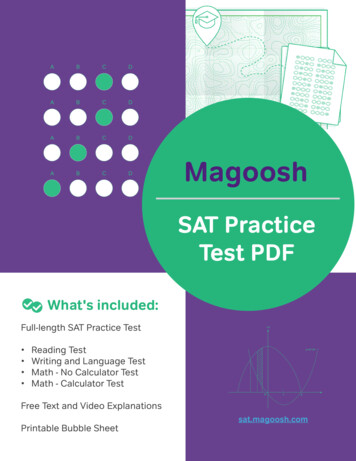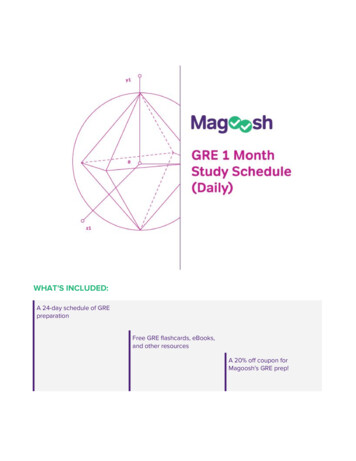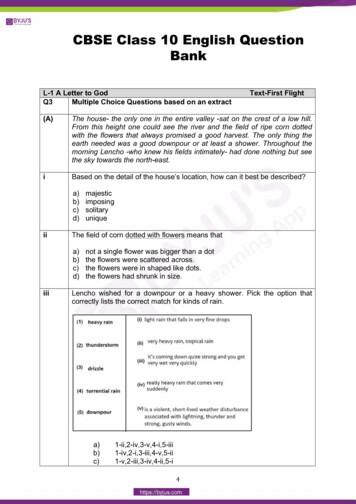
Transcription
MagooshSAT PracticeTest PDFWhat's included:Full-length SAT Practice Test Reading TestWriting and Language TestMath - No Calculator TestMath - Calculator TestFree Text and Video ExplanationsPrintable Bubble Sheetsat.magoosh.com
Hello!Welcome to an important step in your SAT prep! This full-length SAT Practice Test PDF contains 154 ofMagoosh’s highest-quality, student-tested practice questions. Taken from our premium online SAT prep,these questions have been adapted to mimic the official SAT exam that you will encounter on test day.withone key difference.What’s the difference? Well, at the end of this PDF, you will find an answer key and a guide to grading yourpractice test. That’s pretty normal. But, you will also find a link to text and video explanations that showyou how to solve every single question in this practice test.In these explanations, our SAT experts walk you through each question step-by-step. They explain: Which concept the question or problem is testing.Which strategies you can use to answer the question quickly and correctly.Which answer choices are trying to trick you (and how to avoid those traps!).You sure won’t find that in a typical SAT practice test!These explanations will help you take your SAT prep to the next level. Because it’s one thing to take apractice test and call it a day—but if you can learn from your mistakes, then you’re setting yourself up to dobetter when it really counts.Let’s Get Started!Taking a timed, full-length practice test is one of the best ways to prepare yourself for the real SAT.Mimicking test-like conditions will help improve your stamina, pacing, and understanding of your personalstrengths and weaknesses.While you may choose to take this test online (and save some trees while you’re at it), remember that theofficial SAT exam is paper-based. We’ve made this PDF printable so that you can print it out and take it likethe official exam if you want—it’s totally up to you!Here’s What to Expect on the Following Pages: A full-length SAT practice test, in the style of the most current version of the SAT Reading Test (65 Minutes, 52 Questions) Writing and Language Test (35 Minutes, 44 Questions) Math - No Calculator (25 Minutes, 20 Questions) Math - Calculator (35 Minutes, 44 Questions)An answer keyInformation on grading your testLinks to text and video explanations for every single questionsat.magoosh.com2
What You’ll Need to Take the Test: A pencilA timerAn answer sheet to record your answers You will find answer sheets at the end of this PDF. Print them out so that you can practicebubbling your answers, as you will on test day.Practice Test Tips: If you’d like to use this practice test as part of your study schedule, you can substitute it for one of thepractice tests in our SAT Study Schedules here: One Week SAT Study ScheduleOne Month SAT Study ScheduleTwo Month SAT Study ScheduleThree Month SAT Study ScheduleSet aside approximately four hours of uninterrupted time to take the practice test.Try to take the entire practice test in one sitting.Give yourself a brief, 10-minute break after the Reading test.Give yourself a brief, five-minute break after the Math (No Calculator) test.Take the test in a quiet place where you won’t be distracted.Mimic test day conditions by turning off your phone and leaving it in another room.Use a countdown timer and remember to reset it for each test.Eat a healthy, energizing snack before taking the practice test.After the test, check your answers and make note of any questions you missed.Watch the explanation video for every question you get wrong, so that you don’t repeat the samemistakes on test day!Visit sat.magoosh.com to sign up for Magoosh SAT Prep and gain access to more practice questions.Want more tips and tricks? Learn how to stage the perfect SAT practice exam!Good luck!Check out Magoosh SAT Test Prepsat.magoosh.com3
The test begins on the next page. Ready?sat.magoosh.com4
1 1Reading Test65 minutes, 52 questionsTurn to Section 1 of your answer sheet to answer the questions in this section.DIRECTIONSEach passage or pair of passages below is followed by a number of questions.After reading each passage or pair, choose the best answer to each questionbased on what is stated or implied in the passage or passages and in anyaccompanying graphics (such as a table or graph).25Questions 1-10 are based on the followingpassage.It seemed to me that my friendship, mySoon after this I ceased to take lessons ofLine5heart’s affection, meant little to him, for hePokrovski. Even now he thought me a child, awas well-educated, whereas I was stupid,raw schoolgirl, as much as he did Sasha; andand had learned nothing, and had read not athis hurt me extremely, seeing that I had done30long bookshelves where they groaned undermy efforts in this direction no notice had beentheir weight of volumes. I felt filled with grief,taken, and the fact continued to anger medisappointment, and a sort of frenzy. I feltmore and more.that I must read those books, and decided to35possible speed. Probably the idea was that, byPokrovski’s apartment, in the belief that he waslearning whatsoever he knew, I should rendernot at home. Some strange impulse movedmyself more worthy of his friendship. So, Ime to do so. True, we had lived cheek by jowlmade a rush towards the bookcase nearest40me, and, without stopping further to considera glimpse of his abode. Consequently my heartmatters, seized hold of the first dusty tomebeat loudly—so loudly, indeed, that it seemedupon which my hands chanced to alight, and,almost to be bursting from my breast. Onreddening and growing pale by turns, andentering the room I glanced around me withtrembling with fear and excitement, claspedtense interest. The apartment was very poorly20do so—to read them one by one, and with allin Anna Thedorovna’s room, I crept on tiptoe towith one another; yet never once had I caught15single book. So I stood looking wistfully at theso much to atone for my former behavior. OfOne evening, when my mother was sitting10irritation.45the stolen book to my breast with the intentionfurnished, and bore few traces of orderliness.of reading it by candle light while my motherOn table and chairs there lay heaps of books;lay asleep at night.everywhere were books and papers. ThenBut how vexed I felt when, on returninga strange thought entered my head, as wellto our own room, and hastily turning theas, with the thought, an unpleasant feeling ofsat.magoosh.com505pages, only an old, battered worm-eaten LatinCONTINUE
1 1work greeted my eyes! Without loss of timesuch pranks? Are you NEVER going to growI retraced my steps. Just when I was aboutsensible?” With that he darted forward to pickto replace the book I heard a noise in theup the books, while I bent down to help him.corridor outside, and the sound of footsteps55“You need not, you need not!” he went on.90approaching. Fumblingly I hastened tocomplete what I was about, but the tiresomeentered without an invitation.”book had become so tightly wedged into its60657075“You would have done far better not to haveNext, a little mollified by my humblerow that, on being pulled out, it caused itsdemeanor, he resumed in his usual tutorialfellows to close up too compactly to leavetone—the tone which he had adopted in his95any place for their comrade. To insert thenew-found role of preceptor: “When are youbook was beyond my strength; yet still I keptgoing to grow steadier and more thoughtful?pushing and pushing at the row. At last theConsider yourself for a moment. You are norusty nail which supported the shelf (the thinglonger a child, a little girl, but a maiden ofseemed to have been waiting on purpose forfifteen.”100that moment!) broke off short; with the resultThen, with a desire (probably) to satisfythat the shelf descended with a crash, andhimself that I was no longer a being of tenderthe books piled themselves in a heap on theyears, he threw me a glance—but straightwayfloor! Then the door of the room opened, andreddened to his very ears. This I could notPokrovski entered!understand, but stood gazing at him in105I must here remark that he never could bearastonishment. Presently, he straightenedto have his possessions tampered with. Woehimself a little, approached me with a sortto the person, in particular, who touched hisof confused expression, and haltingly saidbooks! Judge, therefore, of my horror whensomething—probably it was an apology for notbooks small and great, books of every possiblehaving perceived that I was now a grown-upshape and size and thickness, came tumbling110young person.1. The central problem the narrator identifies infrom the shelf, and flew and sprang over thetable, and under the chairs, and about thewhole room. I would have turned and fled, but80it was too late. “All is over!” thought I. “All isthis passage is thatover! I am ruined, I am undone! Here have IA) her tutor does not consider her an equal.been playing the fool like a ten-year-old child!B) she has too little education to make herway in the world.What a stupid girl I am! The monstrous fool!”C) her former friend has become estranged.Indeed, Pokrovski was very angry. “What?D) she needs to return a stolen book.Have you not done enough?” he cried. “Are85you not ashamed to be for ever indulging insat.magoosh.com6CONTINUE
1 12.C) reminding her that she had already done theHow does the narrator describe Pokrovski'sdamage.home?D) becoming embarrassed and beginning toA) Orderly and lined with tidy bookshelves.blush.B) Lavish and full of hoarded treasures.C) Spooky and sinister.7.D) Dusty and unorganized.3.answer to the previous question?As it is used in line 6, "in this direction" mostA) Lines 70-71 ("I must.with.")nearly meansB) Lines 84-86 ("'Are you.pranks?")A) having a definite purpose.C) Lines 90-91 ("'You would.invitation.'")B) moving toward a place.D) Lines 100-103 ("Then, with.ears.")C) under specific control.8.D) pointing to this idea.4.Over the course of the passage, the narrator'sA) A sudden fit of insanity.attitude shifts fromB) The desire for companionship.A) annoyance to malevolence.C) Competition between her and Pokrovski.B) resentment to embarrassment.D) The lack of time she had available.9.D) indignation to condescension.Which choice provides the best evidence for theanswer to the previous question?As it is used in line 71, to "bear" most nearlyA) Lines 30-32 ("So I.volumes.")meansB) Lines 32-33 ("I felt.frenzy.")A) endure.C) Lines 33-36 ("I felt.speed.")B) convey.D) Lines 36-38 ("Probably the.friendship.")C) deliver.10. After Pokrovski threw a glance at the narratorD) accept.6.What does the narrator indicate caused her tofeel she "must read those books" (line 34)?C) admiration to disillusionment.5.Which choice provides the best evidence for the(line 102), he immediatelyPokrovski reacts to the narrator's effort to helpA) became too agitated to speak.him gather the fallen books byB) apologized for being possessive.A) demanding she complete the task asC) began to blush profusely.D) reminded her to act her age.repayment.B) pretending to be possessive about hisbooks.sat.magoosh.com7CONTINUE
1 135Questions 11-21 are based on the followingpassage.thoroughly modern pieces based on Westernexperimental musical techniques, like twelve-Arvo Part's famous musical compositionLine5Cantus in Memoriam Benjamin Britten beginstone technique and serialism. The Sovietand ends in silence. After three beats ofUnion in which Part lived did not take kindly40stillness, one musician rings a bell threeroutinely banned Part's compositions fromThe sounds of silence and death give way topublic performance. However, the geniusthe pure voice of strings which flows along inof the work allowed him to win a variety oftheir wake. After a sublime, sorrowful openingawards and accolades even in the Soviet45encouraged him to abandon the moderniststrings follow one another on a quest for thetechniques, and a love of purity began to leaddeepest note, until finally each holds a long,him to the early Western music.At the heart of medieval music is unity.50just one of Part's modern compositions indistinction or ambition. While the modernman and his music.Western techniques discovered new realmsof music, they did so without pursuing unity.Arvo Part recovered the medieval sensehad no musical instrument in the house55except a broken piano. The middle sectionmodern day. After a decade of silence spentsound, leading the boy to experiment withcontemplating this early Western music,the less used notes at the extreme ends ofthe composer reemerged as a mature voicethe keyboard. Some have suggested that thewith Tabula Rasa, Spiegel im Spiegel, and In60Memoriam Benjamin Britten. As part of hismay reflect these early explorations. Heeffort to return to the purity of the medievalbegan formally studying music in 1954,and Renaissance sound, Part invented a newplaying in the military band for severalcompositional technique called tintinnabuli.years. After spending some time as a soundAlthough these classical compositions65producer dabbling in composition, he began30of unified sound and brought it into thewhere most music is played barely made aintense contrasts in his later compositions25Many voices join to become one withoutthe classical style, and it perfectly reveals theBorn in Estonia in 1935, the young Arvo20Union. By 1968, Soviet oppression hadmajor scale into the pulse of the piece. Thesteady low C, then breaks into silence. It is15to this modern Western music, and officialstimes with the slow solemnity of a death toll.in A minor, the violin beckons the warmer C10music, Part had chosen to composewere steeped in the spirit of early music,earnestly studying music from the medievalthey made use of the breadth of Part'sand Renaissance periods. Crystallized in itsexpertise by incorporating elements of thepurity, this early music entranced him.orchestra which did not exist in medievaland Renaissance eras and by dwelling onBefore discovering the medieval and70Renaissance music at the root of Westernsat.magoosh.com8the discordant elements of human emotionCONTINUE
1 112. The main purpose of the first paragraph (linesand experience. The combination of disparate75influences resulted in a pure sound with a1-16) is tomodern story. Part combines these influencesA) explain the purpose of Part’s music.to explore themes of forgiveness, sorrow,B) describe the experience of listening to Part.contemplation, and searching.C) illustrate the importance of music in ourmodern time.Soviet censors, however, continued theD) demonstrate the importance of silence insame opposition toward the new creations ofmusic.the composer as they employed against hisolder work. Part's life as an artist proved very8013. According to the passage, the development ofdifficult. In 1980, he and his wife and sonsPart’s musical voice has been attributed to all offinally managed to move to Austria, then tothe following exceptGermany. A few years later, he met a producerA) Renaissance music.for a European recording label who helpedB) musical instruments in his childhood.spread Part's work. Few classical composers in85C) the tintinnabuli technique.the modern day attain public fame, particularlyD) twelve-tone technique.composers with experimental techniques.However, Part's compositions gained such14. Lines 33-48 (“Before discovering.music.”)notoriety that his concert seats fill with youngmainly serve to suggest thatfamilies, hipsters, college students, and elderly90A) Part adjusted his musical style to gainmusic lovers. Despite Part's distance fromacceptance in the Soviet Union.modern musical fashions, members of everyB) Part's music was shaped primarily by hisage and education level who hear his workhistorical context.understand that they have found somethingC) Part chose each direction for his musicwithout borders: art which expresses the95based on personal interest.questions of humanity.D) Part came to believe that Soviets were rightabout the impurity of modern music.15. The passage suggests that Part introduced11. As it is used in line 22, "extreme" is closest inmeaning towhich modernist aspects into his music?A) intense.A) Elements of orchestraB) ultimate.B) UnityC) profound.C) Themes of forgivenessD) outermost.D) Silencesat.magoosh.com9CONTINUE
1 116. As it is used in line 54, "recovered" most nearly19. The passage implies that Part's musicA) never gained a following in his home, butmeansgrew very popular in the West.A) established.B) so closely matched the spirit of his time thatB) revived.it gained a wide following.C) discovered.C) expressed qualities too universal to go out ofD) replaced.fashion.17. The fourth paragraph (lines 49-75) is primarilyD) gained fame only after he incorporated earlyconcerned with establishing a contrast betweenmusic techniques.A) vocal music and orchestral music.B) modernist influences and themes of20. Which choice provides the best evidence for theanswer to the previous question?forgiveness.C) medieval music and Renaissance music.A) Lines 38-42 ("The Soviet.performance.")D) oneness and disunity.B) Lines 56-60 ("After a.Britten.")C) Lines 84-86 ("Few classical.techniques.")18. Which choice provides the best evidence for theD) Lines 90-95 ("Despite Part's.humanity.")answer to the previous question?A) Lines 50-51 ("Many voices.ambition.")21. According to the passage, Soviet officialsB) Lines 51-53 ("While the.unity.")responded to Part's incorporation of early musicC) Lines 64-71 ("Although these.experience.")into his composition withD) Lines 73-75 ("Part combines.searching.")A) begrudging acceptance.B) increased agitation.C) routine burnings.D) continued opposition.sat.magoosh.com10CONTINUE
1 130Questions 22-31 are based on the followingpassage.so sharply and simply, because there are fewbuildings which have not some pretense orThis passage is adapted from John Ruskin,The Seven Lamps of Architecture, originallypublished 1849. Here, Ruskin describes thefirst principle of architecture.Line5color of being architectural; neither can therebe any architecture which is not based on35not based on good building. However, it isthe structures raised by man for whateverperfectly easy and very necessary to keepuses that the sight of them contributes tothe ideas distinct, and to understand fullyhis mental health, power and pleasure. It isthat Architecture concerns itself only with40very necessary, in the outset of all inquiry, toArchitecture's spirit of sacrifice promptsus to the offering of precious things merelyTo build is by common understanding tobecause they are precious, not becauseput together and adjust the several pieces45of any structure of a considerable size. Theinstance, which of two equally beautiful sortsbut building does not become architectureof marble, both applicable and durable, wouldmerely by the stability of what it erects.choose the more costly because it was so.Of two kinds of decoration, equally effective,50name of Architecture to that art whichthis spirit of sacrifice would choose the moreimpresses on its form certain characterselaborate because it was so. It is thereforevenerable or beautiful, but otherwisemost unreasoning and enthusiastic, andunnecessary. Thus, I suppose, no one wouldperhaps best defined as the opposite of thecall the laws architectural which determineprevalent feeling of modern times, which55the height of a doorframe or the kind of wooddesires to produce the largest results at theleast cost.in a beam. But if to the stone facing of thatOf this spirit of sacrifice, there aredoorframe be added an unnecessary feature,25they are useful or necessary. It is a spirit, forpersons who profess that art are builders,Let us, therefore, at once confine the20those characters of a structure which areabove and beyond its usefulness.and Building.15building, nor any good architecture which isArchitecture is the art which so adornsdistinguish carefully between Architecture10It may not be always easy to draw the lineas a cable molding, that is Architecture. Iftwo distinct forms: the first, the wish toprojecting masses be carved beneath intoexercise self-denial for the sake of self60rounded shapes, which are useless, anddiscipline merely, a wish acted upon in theif the headings of the intervals be archedabandonment of things loved or desired,and engraved, which is useless, that isthere being no direct call or purpose to beArchitecture. This useless nature embodiesanswered by so doing; and the second, thethe first principle of Architecture: sacrifice.desire to honor or please someone else by65sat.magoosh.com11the costliness of the sacrifice.CONTINUE
1 122. What does Ruskin identify as the differenceNearly all old work has been hard work,70work of sacrifice. It may be the hard workbetween building and architecture?of children, of barbarians, of rustics; but itA) Building deals with necessary structures,is always their utmost. Our work looks asbut architecture deals with the unnecessarythough we have stopped short wherever andparts.B) Building deals with new ways of makingwhenever we can. It has the appearance oflazy compliance with low conditions; never ofstructures, but architecture deals witha fair putting forth of our strength. Let us havetraditional ways.C) Building requires sacrifice from the maker,done with this kind of work at once. Cast off75but architecture does not.every temptation to it!D) Building is a good and worthwhile activity,Do not let us degrade ourselves voluntarily,but architecture has no value.and then mutter and mourn over our shortcomings. It is not even a question of how much23. The main purpose of the passage is towe are to do, but of how it is to be done; it is80A) instruct builders regarding the importancenot a question of doing more, but of doingof stability.better. If we have only so much to be spentB) provide a tightly logical argument provingin decoration, let us go to the craftsman,the importance of sacrifice.whoever he may be, and bid him carve for us aC) teach readers that sacrifice is necessary forsingle statue or capital, or as many as we can85architecture.afford, compelling upon him the one condition,D) argue against the needless extravagance ofthat they shall be the best he can do. Placemodern architects.them where they will be of the most value, andbe content. Our other capitals may be mere24. As it is used in line 39, "concerns" most nearlyblocks, and our other niches empty. No matter.90meansBetter our work unfinished than all bad. It isA) worries.more honest and unpretending.B) interests.C) distinguishes.D) decides.sat.magoosh.com12CONTINUE
1 125. According to Ruskin, the spirit of sacrifice28. As it is used in line 70, "stopped short" mostmotivates architects to value what isnearly meansA) necessary.A) been taken by surprise.B) durable.B) were prevented from completion.C) useful.C) left unfinished.D) valuable.D) purposefully limited efforts.26. Based on Ruskin's description of architecture in29. An architect following Ruskin's direction wouldthe seventh paragraph (lines 66-75), it can beNOT useinferred thatA) expensive wood.A) the architects of his time did not valueB) expert laborers.C) the less expensive version of the samesacrifice.material.B) he believes that architects of past ages didD) the most elaborate decorations.careless work.C) modern architects achieve great results inless time than past architects.30. Which choice provides the best evidence for theanswer to the previous question?D) Ruskin believes modern architects are lessA) Lines 14-18 ("Let us.unnecessary.")likely to complete architectural projects thanB) Lines 23-28 ("If projecting.Architecture.")their ancestors.C) Lines 36-41 ("However, it.usefulness.")27. Which choice provides the best evidence for theanswer to the previous question?A) Lines 66-67 ("Nearly all.sacrifice.")D) Lines 45-51 ("It is.was so.")31. The third paragraph (lines 14-29) is primarilyconcerned with establishing a contrast betweenB) Lines 67-69 ("It may.their utmost.")A) indispensable and ornamental structures.C) Lines 69-71 ("Our work.we can.")B) wood and stone materials.D) Lines 73-74 ("Let us.at once.")C) beauty and venerability.D) architecture and sacrifice.sat.magoosh.com13CONTINUE
1 1Questions 32-41 are based on the followingpassages.known as a fracture callus.The fracture callus takes on some of35Passage 1importantly, it develops a mineral matrixDespite the countless advances inLine5which allows bone-building cells known asmedicine over the last hundred years, today'sosteoblasts to travel through it. The manyprimary treatment for broken bones remainschannels that run through the fracture calluslargely identical to the treatment used40line each channel wall with bone. This phasethis is simple: bones are excellent at healinglasts four to six weeks. Once complete, thethemselves. Through a process that may lastbone reaches the stage in which we usuallyweeks or months, the bone and surroundingconsider it healed.45state.complete once the cast comes off, the bodysurrounding blood vessels begin to constrict,is not yet satisfied with its own work. Beneathreducing additional blood loss, and a bloodthe skin, a bulge of bone remains at theclot forms around the fracture site. Loose50years dutifully breaking this bulky tissuerestricted within the blood clot. Cells thatdown and replacing it with compact bonecollect and destroy threatening materialso that it returns to approximately the samebegin to clean the area. At this point, a doctorshape it had initially.55process goes well.Although modern scientists know a greatdeal more about the way that bones repairIt takes a few days for the periostium, thethemselves than scientists of a hundredmembrane that naturally surrounds the bone,years ago did, today's medics still mostlyto respond to the break. The periostial cellstreat fractures in the old fashioned way:closest to the fracture begin to transform25fracture site. The body spends one to threeblood cells, bone fragments, and germs arewill set the bone to ensure that the rest of the20While the person who finally feels wellmay be grateful to think that everything isImmediately after a bone breaks, the15soon fill with osteoblasts, which meticulouslythroughout human history. The reason forcells return the broken bone to its natural10the qualities of the nearby bone. Most60setting bones, making casts, and monitoringand merge into soft cartilage at the fracturethe process. There is simply very little to besite. More distant periostial cells becomedone to improve the natural efficiency of thewoven bone, which work their way toward thebone's healing process.fracture and merge with the soft cartilage.Nearby fibrous cells also transform into30Passage 2cartilage. Before too long, this soft cartilage65Between five and ten percent of boneforms a connection across the fracture gap,fractures result in a phenomenon calleduniting the bone with a somewhat soft band"non-union," in which the bones fail to mendsat.magoosh.com14CONTINUE
1 1In addition to its effectiveness in non-by natural process. If the bone has not begununion cases, electricity has proven somewhatmending 45 days after the fracture event, it70105is considered a non-union case. Therapies toovercome this problem by encouraging unionbone healing when treatment begins at thehave proven effective in many cases.time of the fracture. However, the increase inspeed is not considerable enough to meritExperiments conducted using electricapplication to all broken bones, especiallyenergy to overcome non-union began in75effective at speeding the natural process of1101821. At that time, a British doctor namedwhen weighed against the additional time,Hartshorne attempted to treat a broken boneeffort, and expense required to receiveby passing electric currents through thetreatment.fracture site. One other doctor experimentedwith Hartshorne's findings in the same80century, but the work remained largely ignoreduntil 1953, when a new study on rabbit bonegrowth stimulation using electricity waspublished.Following the 1953 study, a variety of85clinical trials proved that electric currentshelped stimulate bone growth in non-unioncases. In 1971, the electronic therapy helpedovercome non-union in a 51-year-old lady.Since then, the procedure has proven effective90in a small majority of cases. In 1994, theFood and Drug Administration of the UnitedStates of America approved the medical useof electric bone growth stimulation to treatfractures.95The key to this treatment's effectiveness isnot the application of electricity to the boneitself, but the way the electricity influences thecells surrounding the fracture. Electric currentsencourage collagen production, mineralization100processes, and the speed with which the bodytransports needed nutrients to the fracturesite.sat.magoosh.com15CONTINUE
1 132. According to Passage 1, the membrane35. Which choice best describes the view Passagesurrounding the bone2's author holds of electric therapy applied inA) cleans up the fracture site.normal union fractures?B) sets the broken bone.A) The treatment has no effect.C) creates the soft cartilage.B) The benefits are worth the increased effort.D) coats the channels with bone.C) The treatment is too dangerous for use innormal cases.33. Passage 1 states that returning the bulgingD) There are not enough benefits to outweighbone to its original shape takesthe costs.A) weeks or months.B) several days.36. Which choice provides the best evidenceC) four to six weeks.from Passage 2 for the answer to the previousD) one to three years.question?A) Lines 70-73 ("Therapies to.cases.")34. As it is used in line 16, "restricted" most nearlyB) Lines 90-94 (In 1994.fractures.")meansC) Lines 103-107 ("In a
Welcome to an important step in your SAT prep! This full-length SAT Practice Test PDF contains 154 of Magoosh’s highest-quality, student-tested practice questions. Taken from our premium online SAT prep, these questions have been adapted to mimic the official SAT exam that you will encounte











